A Comparison of Three Types of Permeable Pavements for Urban Runoff Mitigation in the Semi-Arid South Texas, U.S.A
Abstract
1. Introduction
2. Materials and Methods
2.1. Site Description
2.2. Pavements Cross Section
2.3. Characterization of Pavement Materials
2.4. Runoff Monitoring and Analysis
2.5. Water Quality Analysis
3. Results and Discussion
3.1. Peak Flow, Runoff Reduction, and Storage
3.2. Water Quality Analysis
3.3. Influence of Design Parameters on Permeable Pavements Performance
4. Conclusions
- PCP, PICP, and IBPG showed a significant attenuation of peak flow and surface runoff volume for most of the monitoring events in the semi-arid climatic region of South Texas.
- Because of the higher infiltration rates and underdrain provision, the existing PCP design demonstrated the most optimal higher runoff volume reductions over PICP and IBPG.
- In terms of storage perspective, the existing IBPG design might have a better prospect of holding a significant volume of infiltrated runoff prior to subsurface drainage.
- The attenuation of peak flow and runoff volume was quite notable for this region as compared to other regions studied, perhaps because of the increased infiltration due to enhanced aggregate porosity in the bedding layers and soil types.
- PCP and IBPG significantly demonstrated an improved TSS and BOD5 removal over monitored traditional pavements. PCP was the most optimal in accumulating particulate solids within its surface and void matrices. However, IBPG appeared to be a better solution for BOD5 removal, perhaps due to its potential to trap organic particles within the pea gravel filled cell openings. In this semi-arid climatic region of the LRGV, the TSS concentrations at the PCP, PICP, and IBPG outfall was somewhat higher than the values obtained from other climatic regions.
- The surface characteristics of permeable pavements have a large effect on surface runoff volumes despite having similar characteristics of the base aggregates.
- The characteristics of the base reservoirs (storage capacity and aggregate size) had a higher influence on surface infiltration and the maximum rainfall holding depth prior to flooding.
Supplementary Materials
Author Contributions
Funding
Acknowledgments
Conflicts of Interest
References
- TCEQ. 2014 Texas Integrated Report—Texas 303(d) List (Category 5); TCEQ: Austin, TX, USA, 2014. [Google Scholar]
- ACWP. Update to the Arroyo Colorado Watershed Protection Plan; Texas Water Resources Institute: College Station, TX, USA, 2017; pp. 3–152. [Google Scholar]
- Hunt, W.F., III. Working with Regulators to Change Permeable Pavements Acceptance. In Proceedings of the 9th International Conference on Concrete Block Paving, Buenos Aires, Argentina, 18–21 October 2009; pp. 1270–1280. [Google Scholar]
- Drake, J.A.P.; Bradford, A.; Marsalek, J. Review of environmental performance of permeable pavement systems: State of the knowledge. Water Qual. Res. J. 2013, 48, 203–222. [Google Scholar] [CrossRef]
- Scholz, M.; Grabowiecki, P. Review of permeable pavement systems. Build. Environ. 2007, 42, 3830–3836. [Google Scholar] [CrossRef]
- Imran, H.M.; Akib, S.; Karim, M.R. Permeable pavement and stormwater management systems: A review. Environ. Technol. 2013, 34, 2649–2656. [Google Scholar] [CrossRef] [PubMed]
- Huang, J.; He, J.; Valeo, C.; Chu, A. Temporal evolution modeling of hydraulic and water quality performance of permeable pavements. J. Hydrol. 2016, 533, 15–27. [Google Scholar] [CrossRef]
- Kumar, K. Review on permeable pavement systems. In Proceedings of the 11th Transportation Planning and Implementation Methodologies for Developing Countries (11th TPMDC), Bombay, India, 10–12 December 2014; Transportation Systems Engineering (TSE) Group, Indian Institute of Technology: Bombay, India Poster No. 15. [Google Scholar]
- Dietz, M.E. Low impact development practices: A review of current research and recommendations for future directions. Water. Air. Soil Pollut. 2007, 186, 351–363. [Google Scholar] [CrossRef]
- Bean, E.Z.; Hunt, W.F.; Bidelspach, D.A. Field survey of permeable pavement surface infiltration rates. J. Irrig. Drain. Eng. 2007, 133, 249–255. [Google Scholar] [CrossRef]
- Bean, E.Z.; Hunt, W.F.; Bidelspach, D.A. Evaluation of four permeable pavement sites in Eastern North Carolina for runoff reduction and water quality impacts. J. Irrig. Drain. Eng. 2007, 133, 583–592. [Google Scholar] [CrossRef]
- Brattebo, B.O.; Booth, D.B. Long-term stormwater quantity and quality performance of permeable pavement systems. Water Res. 2003, 37, 4369–4376. [Google Scholar] [CrossRef]
- Collins, K.A.; Hunt, W.F.; Hathaway, J.M. Hydrologic comparison of four types of permeable pavement and standard asphalt in Eastern North Carolina. J. Hydrol. Eng. 2008, 13, 1146–1157. [Google Scholar] [CrossRef]
- Sansalone, J.; Kuang, X.; Ranieri, V. Permeable pavement as a hydraulic and filtration interface for urban drainage. J. Irrig. Drain. Eng. 2008, 134, 666–674. [Google Scholar] [CrossRef]
- Ball, J.E.; Rankin, K. The hydrological performance of a permeable pavement. Urban Water J. 2010, 7, 79–90. [Google Scholar] [CrossRef]
- Tota-Maharaj, K.; Scholz, M. Efficiency of permeable pavement systems for the removal of urban runoff pollutants under varying environmental conditions. Environ. Prog. Sustain. Energy 2010, 29, 358–369. [Google Scholar] [CrossRef]
- Beecham, S.; Pezzaniti, D.; Kandasamy, J. Stormwater treatment using permeable pavements. Proc. Inst. Civ. Eng. 2012, 165, 161–170. [Google Scholar] [CrossRef]
- Huang, J.; Valeo, C.; He, J.; Chu, A. Winter performance of inter-locking pavers—Stormwater quantity and quality. Water 2012, 4, 995–1008. [Google Scholar] [CrossRef]
- Roseen, R.M.; Ballestero, T.P.; Houle, J.J.; Briggs, J.F.; Houle, K.M. Water quality and hydrologic performance of a porous asphalt pavement as a storm-water treatment strategy in a cold climate. J. Environ. Eng. 2012, 138, 81–89. [Google Scholar] [CrossRef]
- Mahmoud, A.; Alam, T.; Yeasir, A.; Rahman, M.; Sanchez, A.; Guerrero, J.; Jones, K.D. Evaluation of field-scale stormwater bioretention structure flow and pollutant load reductions in a semi-arid coastal climate. Ecol. Eng. X 2019, 1, 100007. [Google Scholar] [CrossRef]
- Fassman, E.A.; Blackbourn, S. Urban runoff mitigation by a permeable pavement system over impermeable soils. J. Hydrol. Eng. 2010, 15, 475–485. [Google Scholar] [CrossRef]
- Winston, R.J.; Dorsey, J.D.; Smolek, A.P.; Hunt, W.F. Hydrologic performance of four permeable pavement systems constructed over low-permeability soils in Northeast Ohio. J. Hydrol. Eng. 2018, 23, 04018007. [Google Scholar] [CrossRef]
- Dreelin, E.A.; Fowler, L.; Ronald Carroll, C. A test of porous pavement effectiveness on clay soils during natural storm events. Water Res. 2006, 40, 799–805. [Google Scholar] [CrossRef]
- Kwiatkowski, M.; Welker, A.L.; Traver, R.G.; Vanacore, M.; Ladd, T. Evaluation of an infiltration best management practice utilizing pervious concrete. J. Am. Water Resour. Assoc. 2007, 43, 1208–1222. [Google Scholar] [CrossRef]
- Pratt, C.J.; Mantle, J.D.G.; Schofield, P.A. UK research into the performance of permeable pavement, reservoir structures in controlling stormwater discharge quantity and quality. Innov. Technol. Urban Storm Drain. 1995, 32, 63–69. [Google Scholar] [CrossRef]
- Saadeh, S.; Ralla, A.; Al-Zubi, Y.; Wu, R.; Harvey, J. Application of fully permeable pavements as a sustainable approach for mitigation of stormwater runoff. Int. J. Transp. Sci. Technol. 2019. [Google Scholar] [CrossRef]
- Kayhanian, M.; Li, H.; Harvey, J.T.; Liang, X. Application of permeable pavements in highways for stormwater runoff management and pollution prevention: California research experiences. Int. J. Transp. Sci. Technol. 2019. [Google Scholar] [CrossRef]
- LeFevre, N.-J.B.; Watkins, D.W.; Gierke, J.S.; Brophy-Price, J. Hydrologic performance monitoring of an underdrained low-impact development storm-water management system. J. Irrig. Drain. Eng. 2010, 136, 333–339. [Google Scholar] [CrossRef]
- Brown, C.; Chu, A.; van Duin, B.; Valeo, C. Characteristics of sediment removal in two types of permeable pavement. Water Qual. Res. J. 2009, 44, 59–70. [Google Scholar] [CrossRef]
- Lucke, T.; Beecham, S. Field investigation of clogging in a permeable pavement system. Build. Res. Inf. 2011, 39, 603–615. [Google Scholar] [CrossRef]
- Eck, B.J.; Winston, R.J.; Hunt, W.F.; Barrett, M.E. Water quality of drainage from permeable friction course. J. Environ. Eng. 2012, 138, 174–181. [Google Scholar] [CrossRef]
- Legret, M.; Colandini, V.; Le Marc, C. Effects of a porous pavement with reservoir structure on the quality of runoff water and soil. Sci. Total Environ. 1996, 189–190, 335–340. [Google Scholar] [CrossRef]
- Pagotto, C.; Legret, M.; Le Cloirec, P. Comparison of the hydraulic behaviour and the quality of highway runoff water according to the type of pavement. Water Res. 2000, 34, 4446–4454. [Google Scholar] [CrossRef]
- Chopra, M.; Kakuturu, S.; Ballock, C.; Spence, J.; Wanielista, M. Effect of rejuvenation methods on the infiltration rates of pervious concrete pavements. J. Hydrol. Eng. 2010, 15, 426–433. [Google Scholar] [CrossRef]
- Al-Rubaei, A.M.; Stenglein, A.-L.; Viklander, M.; Blecken, G.-T. Long-term hydraulic performance of porous asphalt pavements in Northern Sweden. J. Irrig. Drain. Eng. 2013, 139, 499–505. [Google Scholar] [CrossRef]
- Kuruppu, U.; Rahman, A.; Sathasivan, A. Enhanced denitrification by design modifications to the standard permeable pavement structure. J. Clean. Prod. 2019, 237, 117721. [Google Scholar] [CrossRef]
- Razzaghmanesh, M.; Borst, M. Long-term effects of three types of permeable pavements on nutrient infiltrate concentrations. Sci. Total Environ. 2019, 670, 893–901. [Google Scholar] [CrossRef] [PubMed]
- Ahiablame, L.M.; Engel, B.A.; Chaubey, I. Effectiveness of low impact development practices: Literature review and suggestions for future research. Water. Air Soil Pollut. 2012, 223, 4253–4273. [Google Scholar] [CrossRef]
- Kayhanian, M.; Weiss, P.T.; Gulliver, J.S.; Khazanovich, L. The Application of Permeable Pavement with Emphasis on Successful Design, Water Quality Benefits, and Identification of Knowledge and Data Gaps; National Center for Sustainable Transportation: Davis, CA, USA, 2015. [Google Scholar]
- Alam, T.; Mahmoud, A.; Jones, D.K.; Bezares-Cruz, C.J.; Guerrero, J. WinSLAMM simulation of hydrologic performance of permeable pavements—A case study in the semi-arid Lower Rio Grande Valley of South Texas, United States. Water 2019, 11, 1865. [Google Scholar] [CrossRef]
- HKO Climatological Information for Brownsville, United States. Available online: http://www.hko.gov.hk/wxinfo/climat/world/eng/n_america/us/brownsville_e.htm (accessed on 29 August 2018).
- NOAA National Weather Service Forcecast Office, Brownsville, TX. Available online: https://w2.weather.gov/climate/xmacis.php?wfo=bro (accessed on 29 August 2018).
- North Carolina Department of Environmental and Natural Resources. Updated Draft Manual of Stormwater Best Management Practices; NCDENR: Raleigh, NC, USA, 2006. [Google Scholar]
- Weiss, P.T.; Kayhanian, M.; Gulliver, J.S.; Khazanovich, L. Permeable pavement in northern North American urban areas: Research review and knowledge gaps. Int. J. Pavement Eng. 2019, 20, 143–162. [Google Scholar] [CrossRef]
- Van Duin, B.; Brown, C.; Chu, A.; Marsalek, J.; Valeo, C. Characterization of long-term solids removal and clogging processes in two types of permeable pavement under cold climate conditions. In Proceedings of the 11th International Conference on Urban Drainage, Edinburgh, UK, 31 August–5 September 2008. [Google Scholar]
- Huang, J.; Valeo, C.; He, J.; Chu, A. Three types of permeable pavements in cold climates: Hydraulic and environmental performance. J. Environ. Eng. 2016, 142, 04016025. [Google Scholar] [CrossRef]
- Drake, J.; Bradford, A.; Van Seters, T.; MacMillan, G. Evaluation of Permeable Pavements in Cold Climates-Kortright Centre, Vaughan; Toronto and Region Conservation Authority: Toronto, ON, Canada, 2012. [Google Scholar]
- Passeport, E.; Hunt, W.F.; Line, D.E.; Smith, R.A.; Brown, R.A. Field study of the ability of two grassed bioretention cells to reduce storm-water runoff pollution. J. Irrig. Drain. Eng. 2009, 135, 505–510. [Google Scholar] [CrossRef]
- Zhang, B.; Song, X.; Zhang, Y.; Han, D.; Tang, C.; Yu, Y.; Ma, Y. Hydrochemical characteristics and water quality assessment of surface water and groundwater in Songnen plain, Northeast China. Water Res. 2012, 46, 2737–2748. [Google Scholar] [CrossRef]
- Palmer, E.T.; Poor, C.J.; Hinman, C.; Stark, J.D. Nitrate and phosphate removal through enhanced bioretention media: Mesocosm study. Water Environ. Res. 2013, 85, 823–832. [Google Scholar] [CrossRef]
- Abdollahian, S.; Kazemi, H.; Rockaway, T.; Gullapalli, V. Stormwater quality benefits of permeable pavement systems with deep aggregate layers. Environments 2018, 5, 68. [Google Scholar] [CrossRef]
- Guo, Y.; Li, Y.; Wang, Y.; Gao, K.; Yang, L.; Qin, X.; Du, J.-G.; Wang, S. Study on pollutants removal performance of some biological carrier in wastewater land treatment system. Environ. Sci. Technol. 2009, 22, 33–35. (In Chinese) [Google Scholar]
- Li, W.; Ma, G.; Lu, L.; Li, S. The research of structure and performance of adsorption of modified fly ash and apply it to the waste water treatment. Mod. Sci. Instrum. 2006, 2. [Google Scholar] [CrossRef]
- Xiang, H.; Han, Y.; Liu, Y. Substrate screening for phosphorus removal in low concentration phosphorus-containing water body. Acta Sci. Circumstantiae 2013, 33, 3227–3233. (In Chinese) [Google Scholar]
- Koupai, J.A.; Nejad, S.S.; Mostafazadeh-Fard, S.; Behfarnia, K. Reduction of Urban Storm-Runoff Pollution Using Porous Concrete Containing Iron Slag Adsorbent. J. Environ. Eng. 2016, 142, 04015072. [Google Scholar] [CrossRef]
- Saghaian, N.S.; Abedi-Koupai, J.; Mostafazadeh-Fard, S.; Behfarnia, K. Treatment of urban storm water using adsorbent porous concrete. Proc. Inst. Civ. Eng. Water Manag. 2017, 171, 328–334. [Google Scholar] [CrossRef]
- Marchioni, M.; Becciu, G. Experimental results on permeable pavements in urban areas: A synthetic review. Int. J. Sustain. Dev. Plan. 2015, 10, 806–817. [Google Scholar] [CrossRef]
- Rodriguez-Hernandez, J.; Andrés-Valeri, V.C.; Ascorbe-Salcedo, A.; Castro-Fresno, D. Laboratory study on the stormwater retention and runoff attenuation capacity of four permeable pavements. J. Environ. Eng. 2016, 142, 04015068. [Google Scholar] [CrossRef]
- Kamali, M.; Delkash, M.; Tajrishy, M. Evaluation of permeable pavement responses to urban surface runoff. J. Environ. Manag. 2017, 187, 43–53. [Google Scholar] [CrossRef]
- Liu, Y.C.; Chui, F.T. Factors Influencing stormwater mitigation in permeable pavement. Water 2017, 9, 988. [Google Scholar]
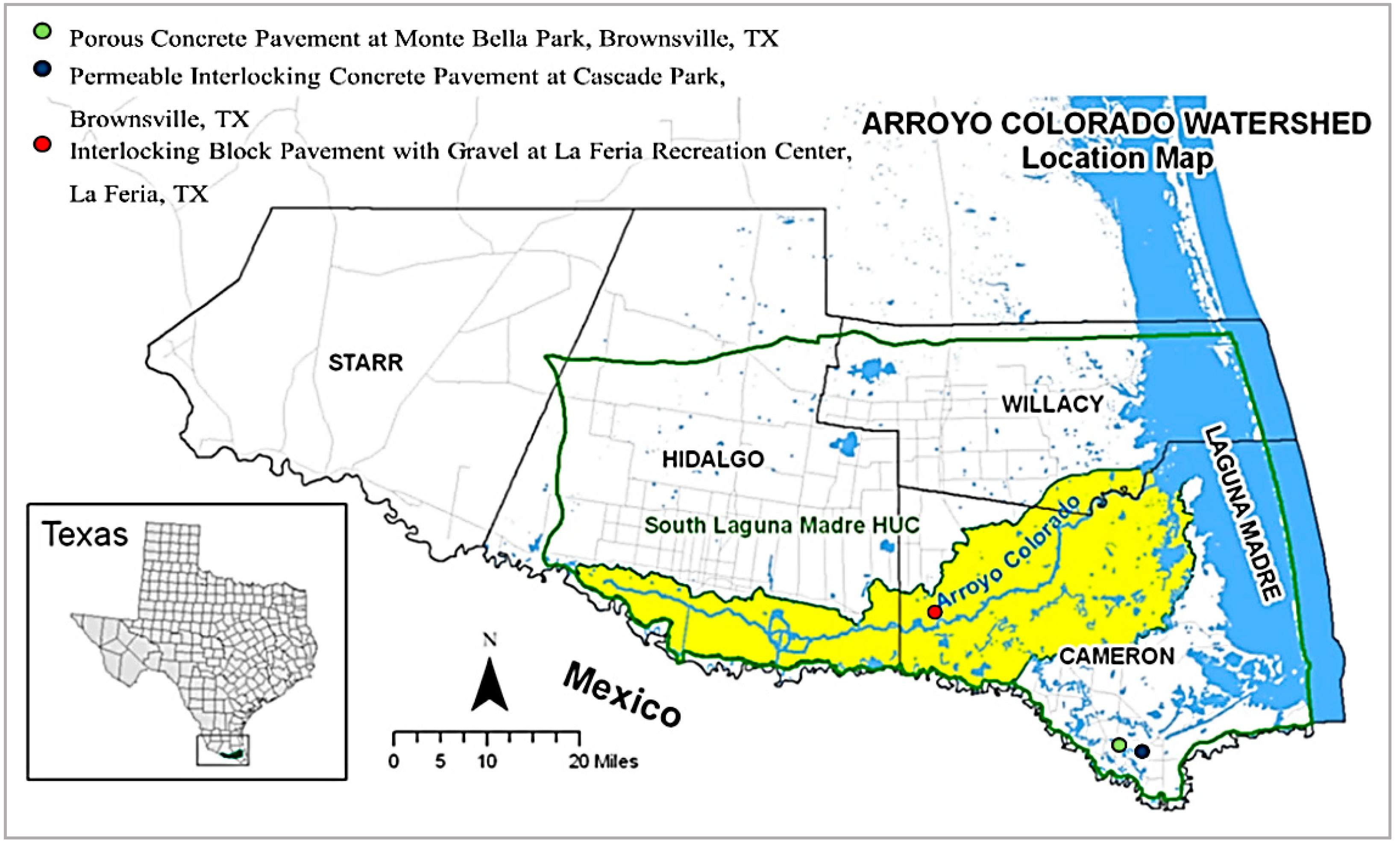
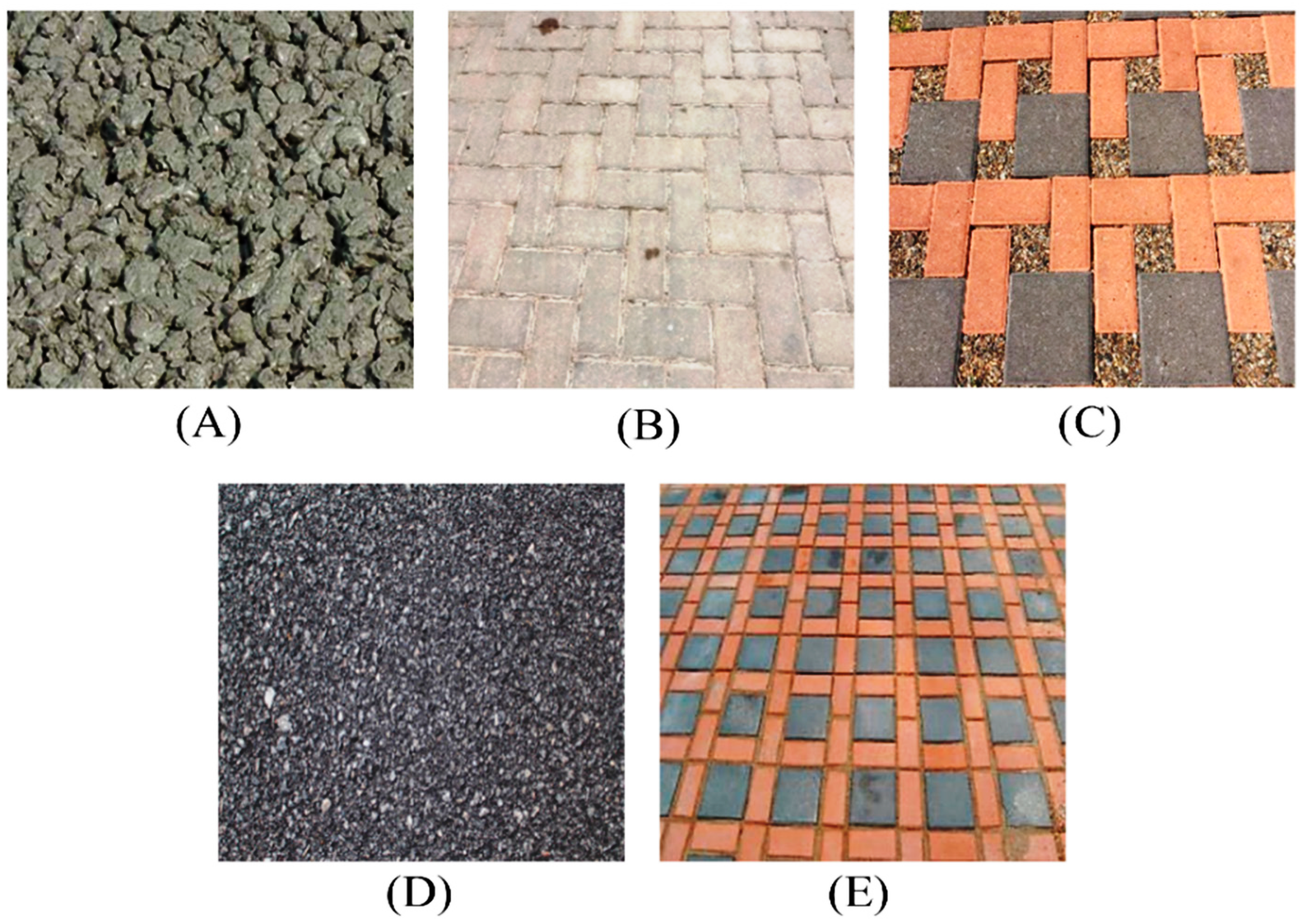
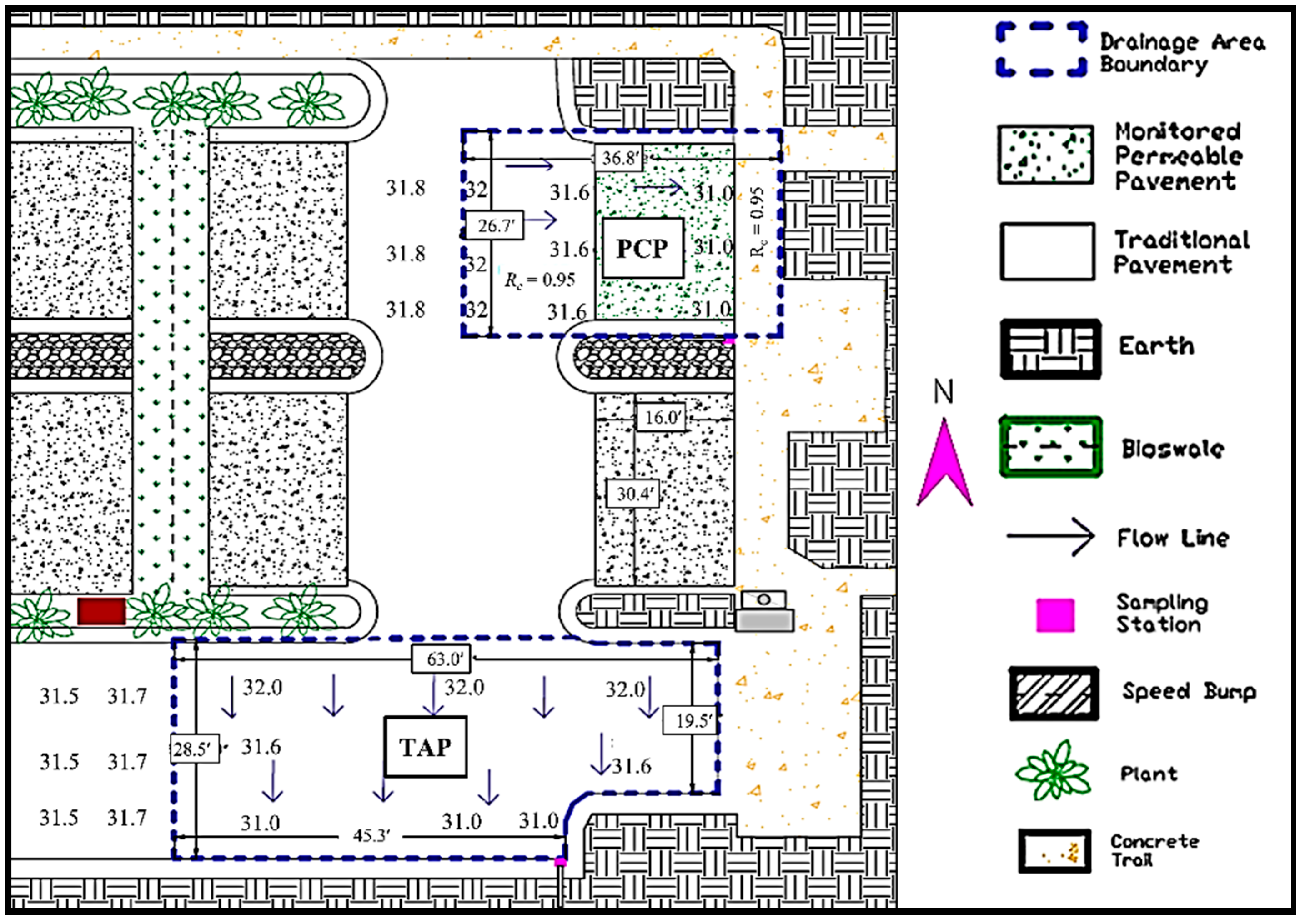
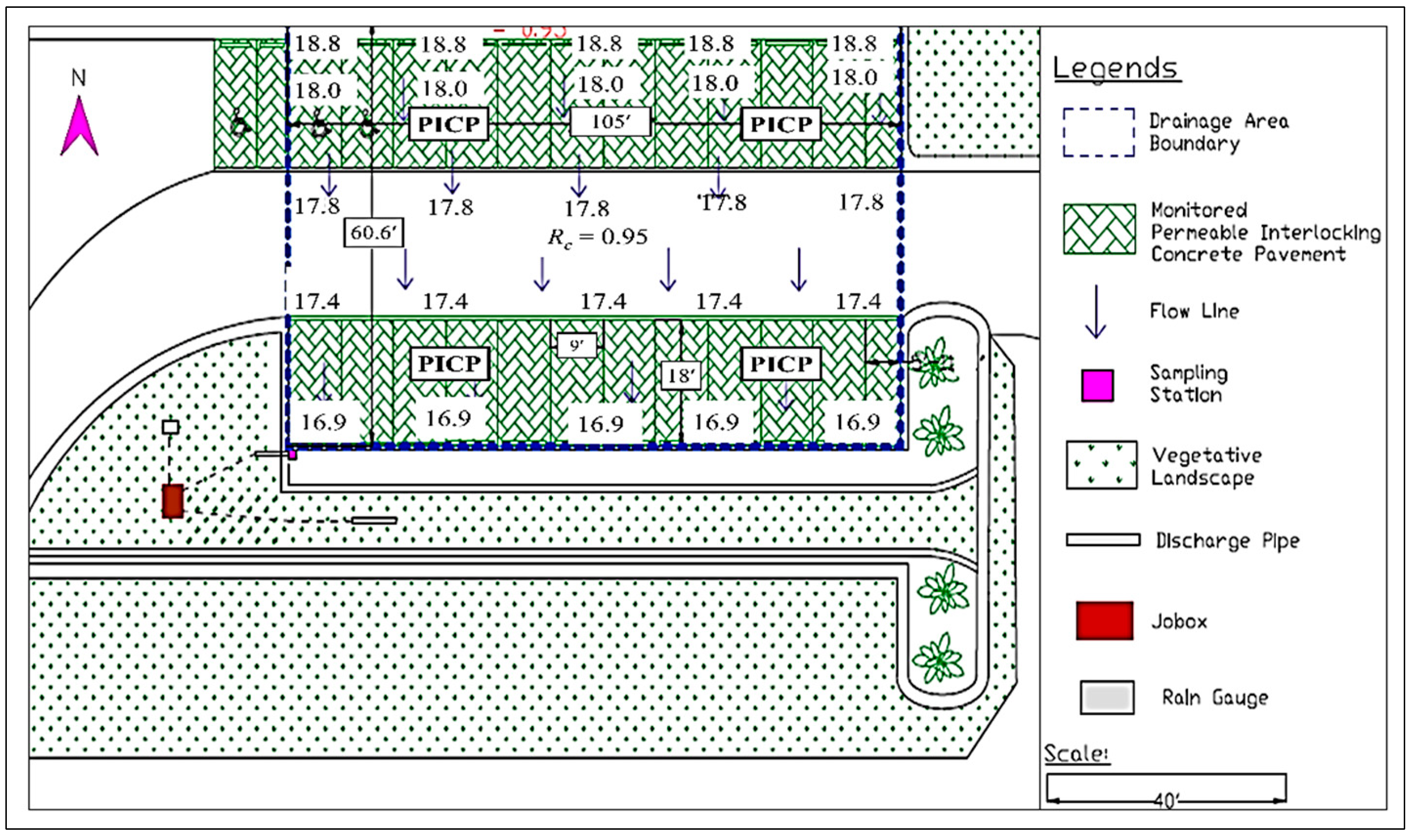
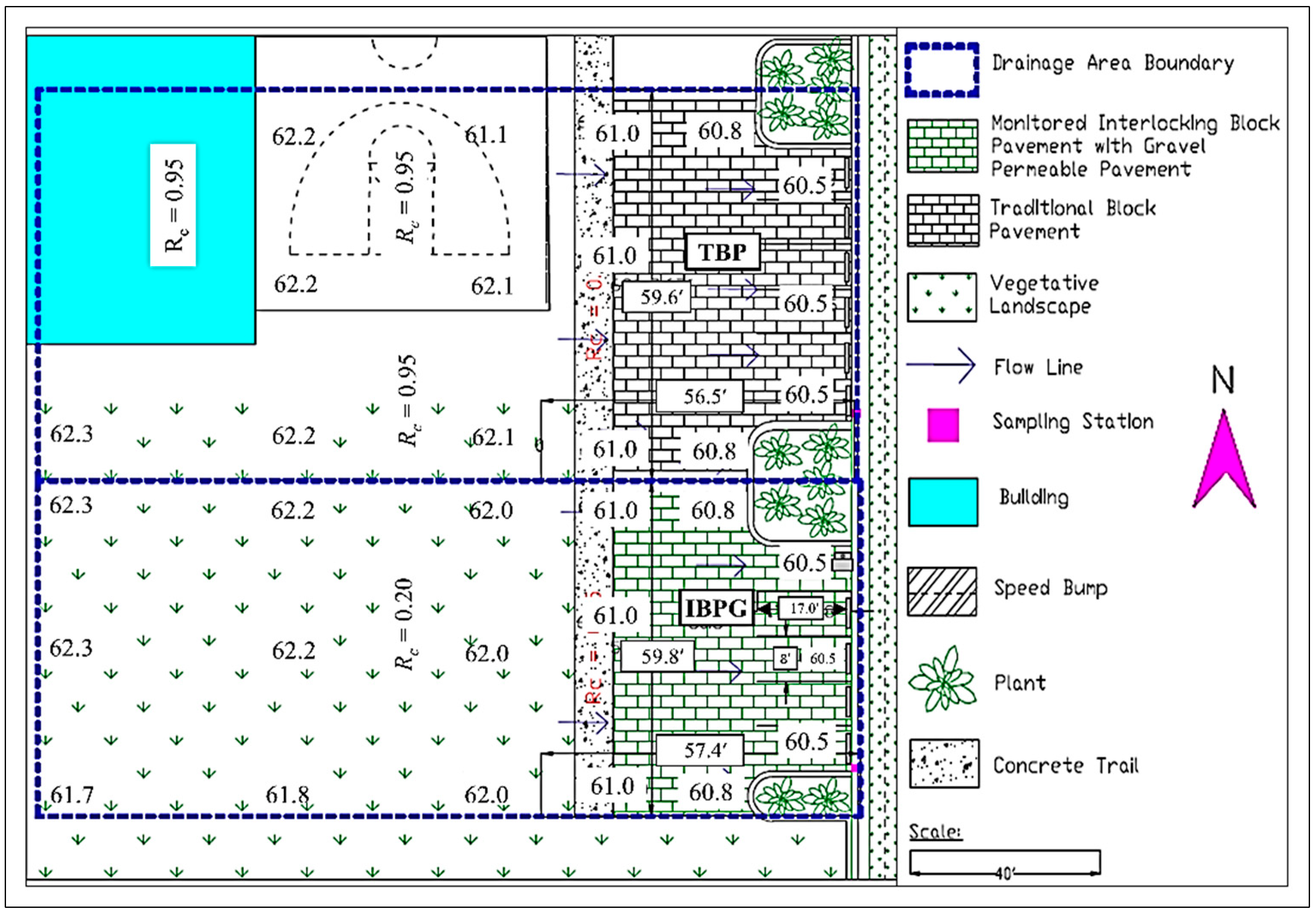

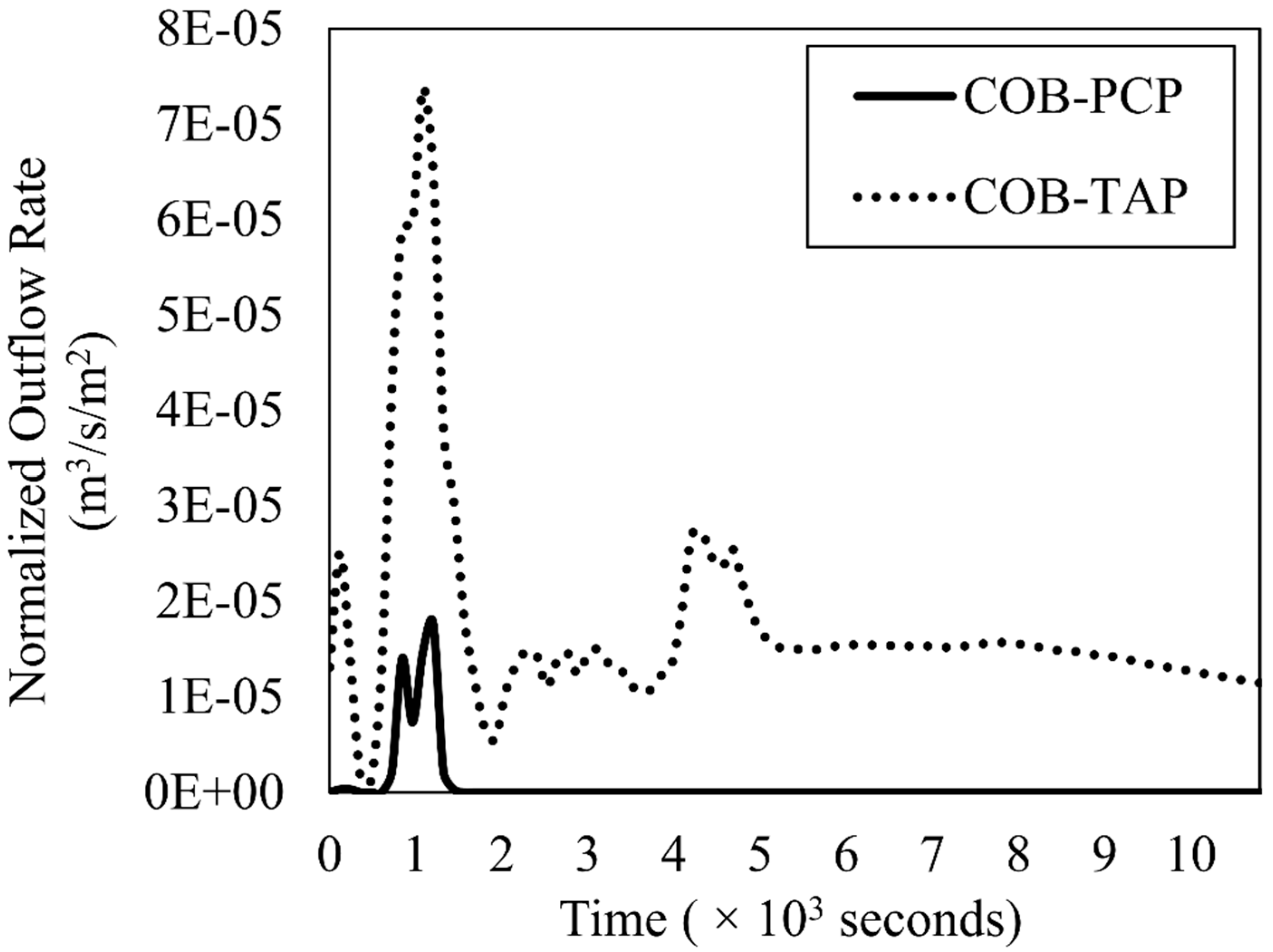
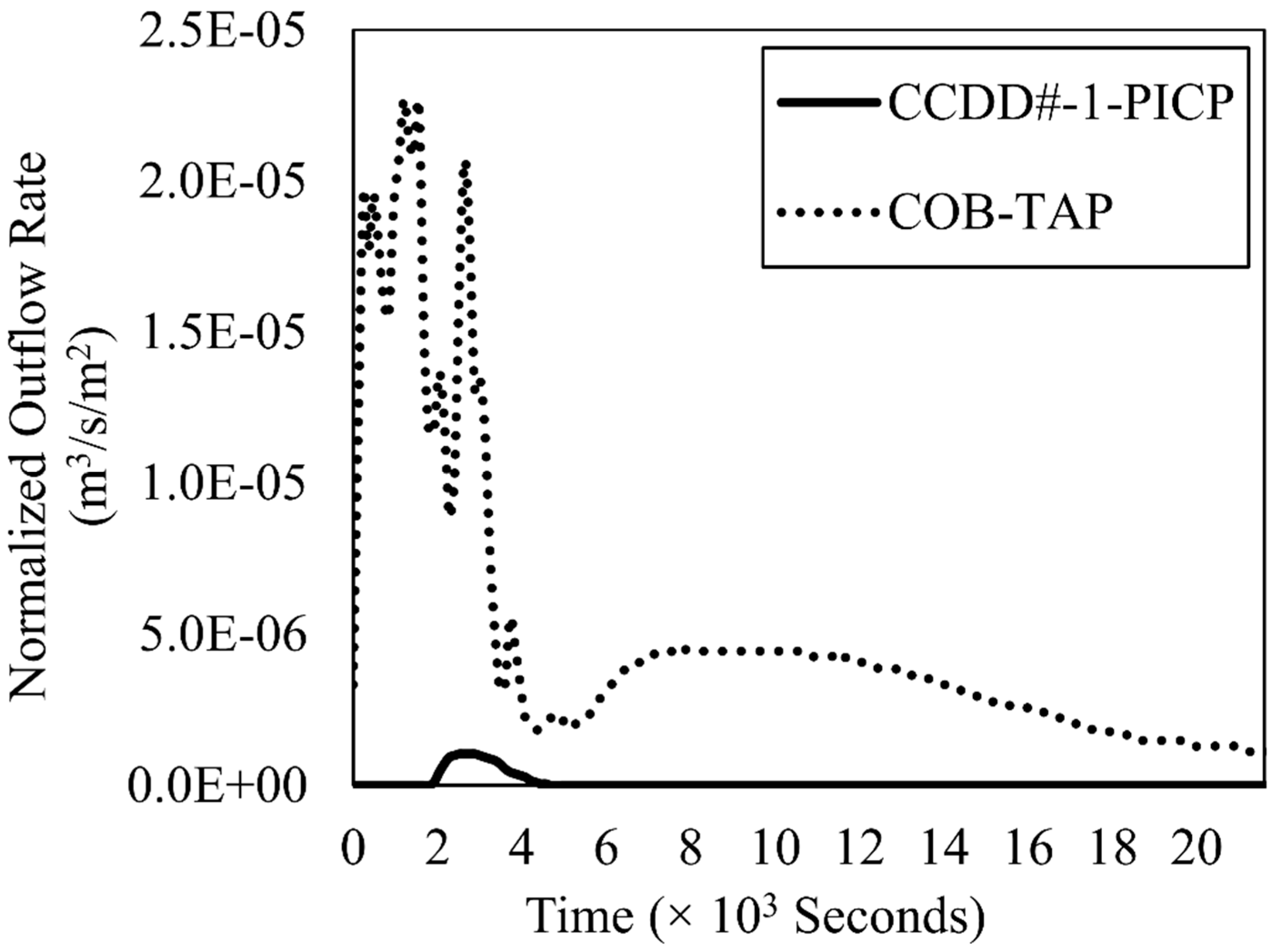
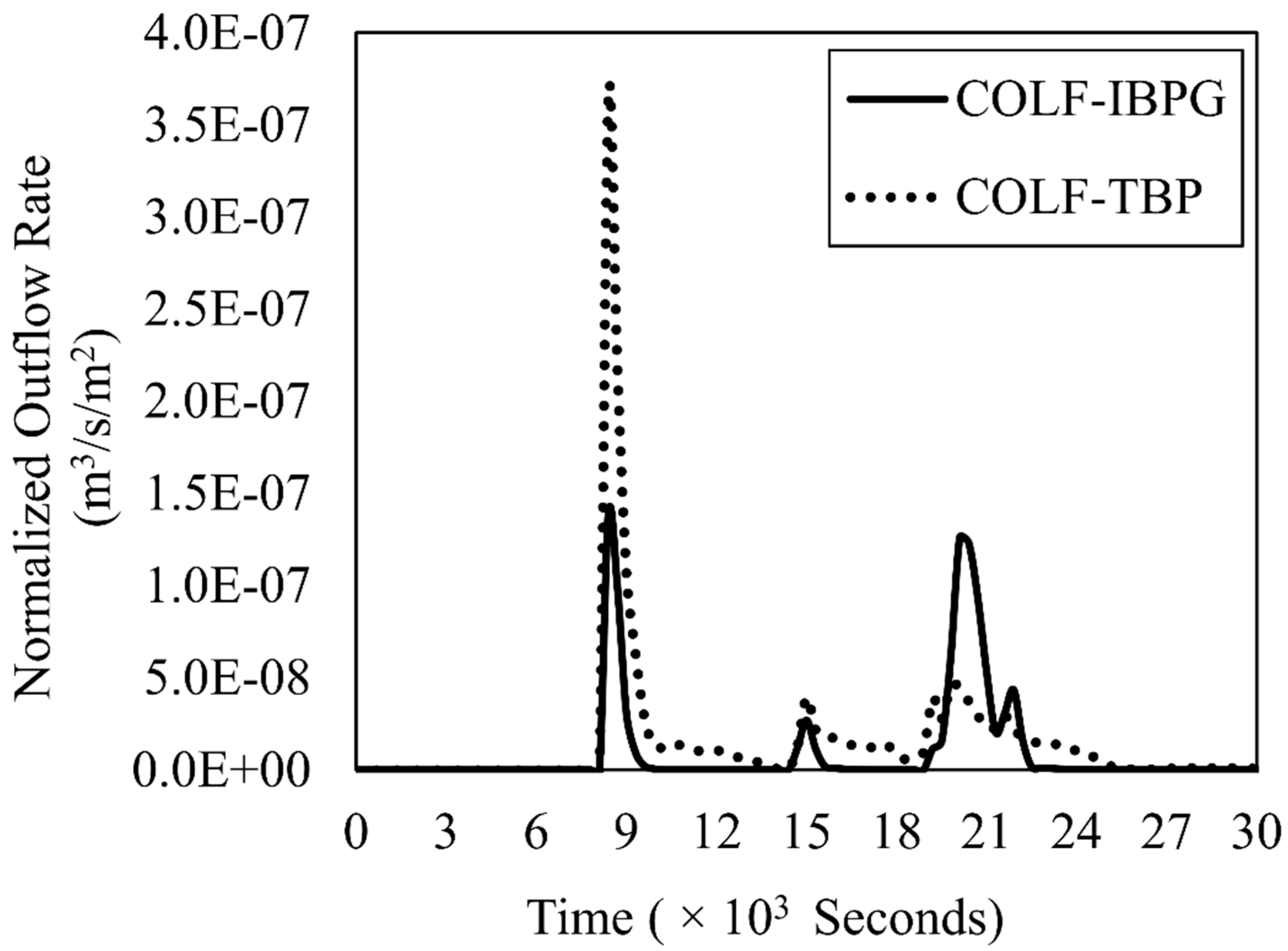
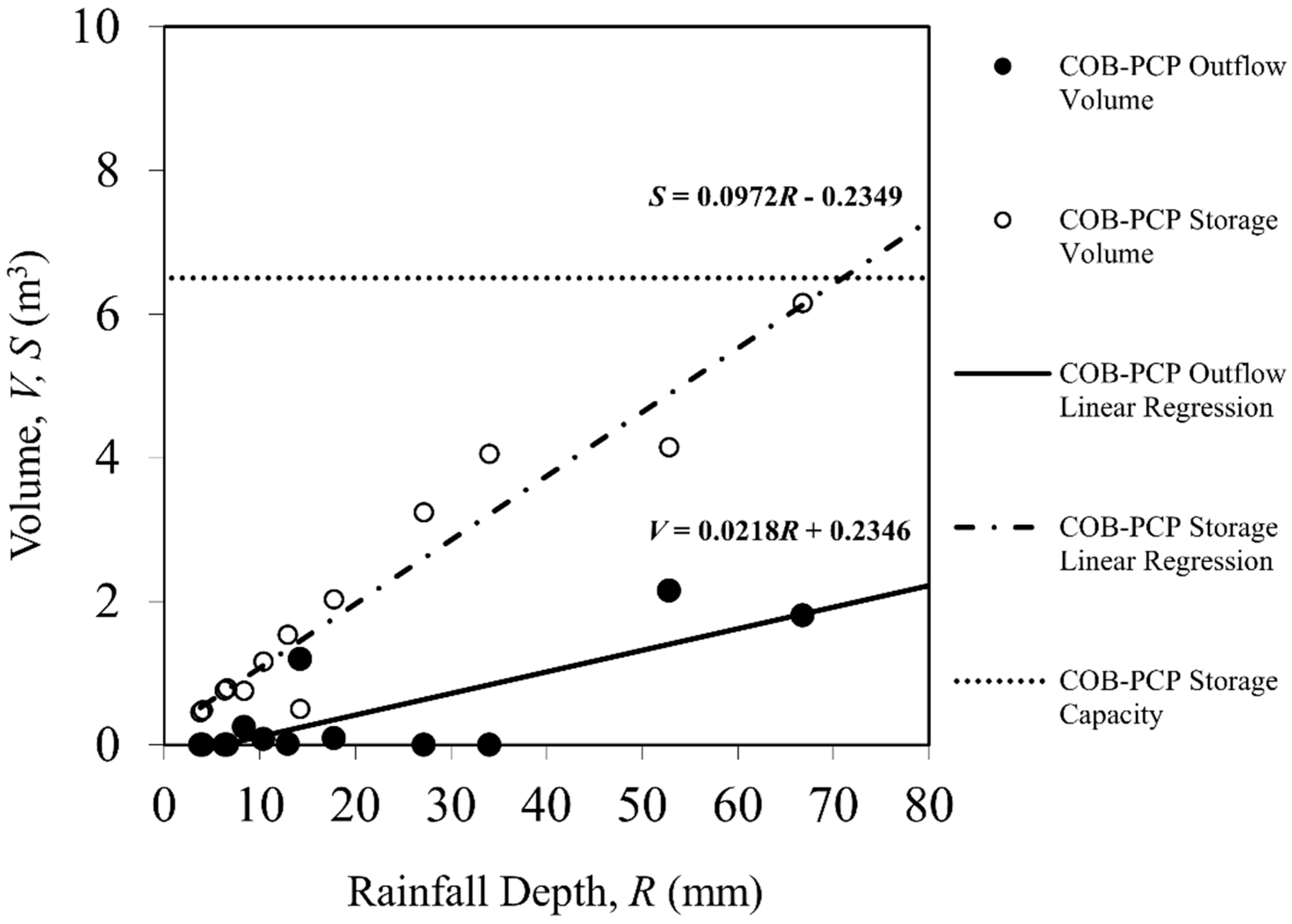
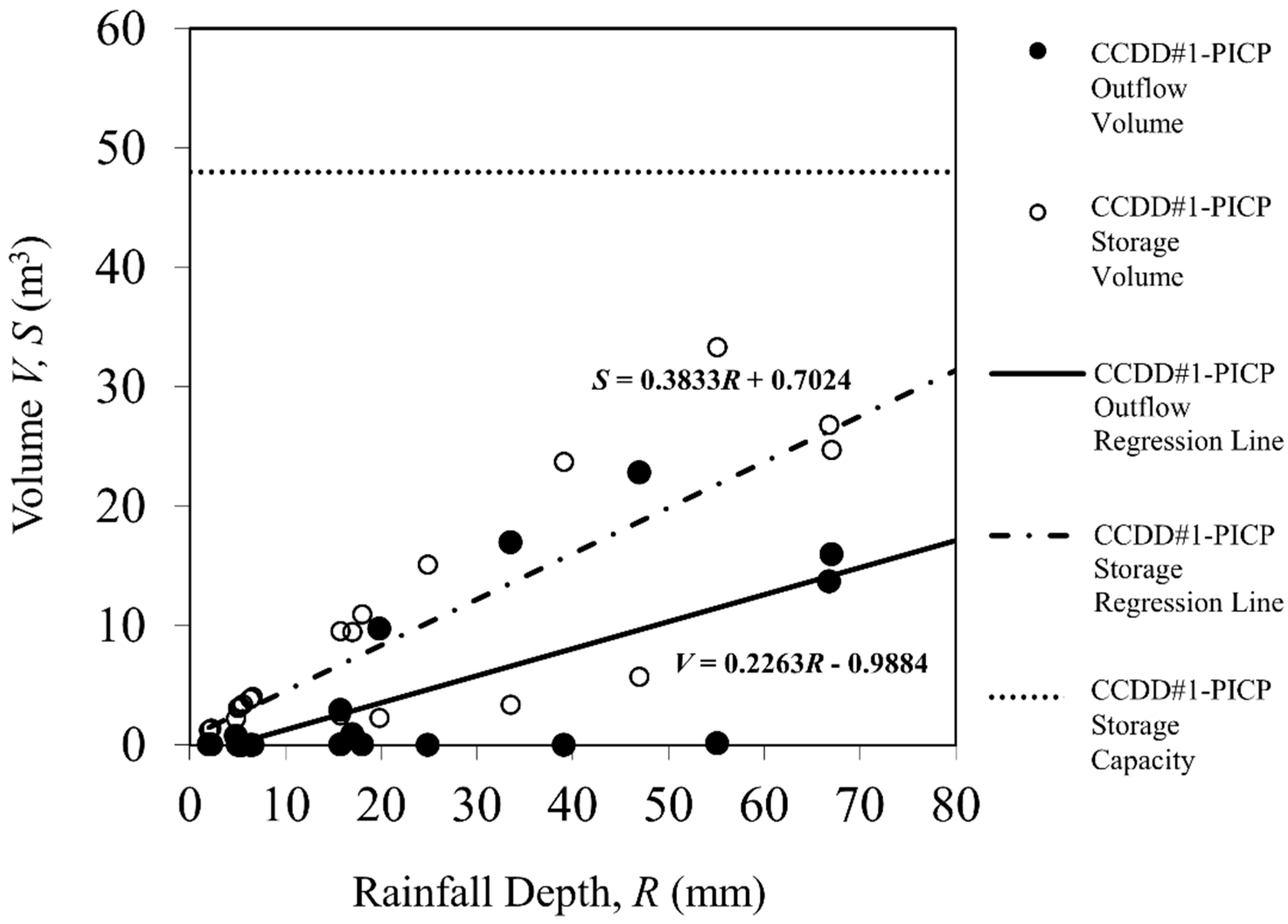
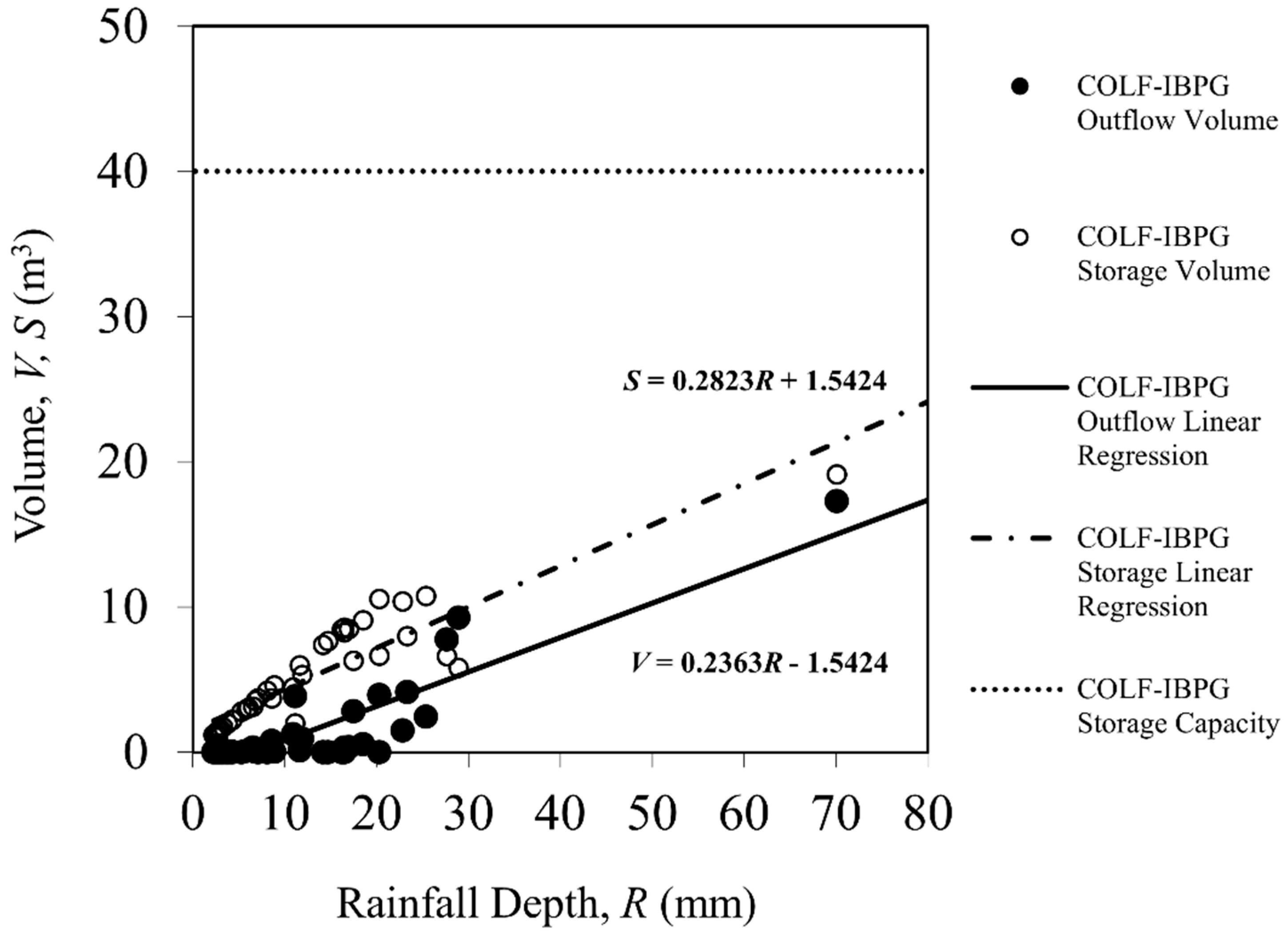
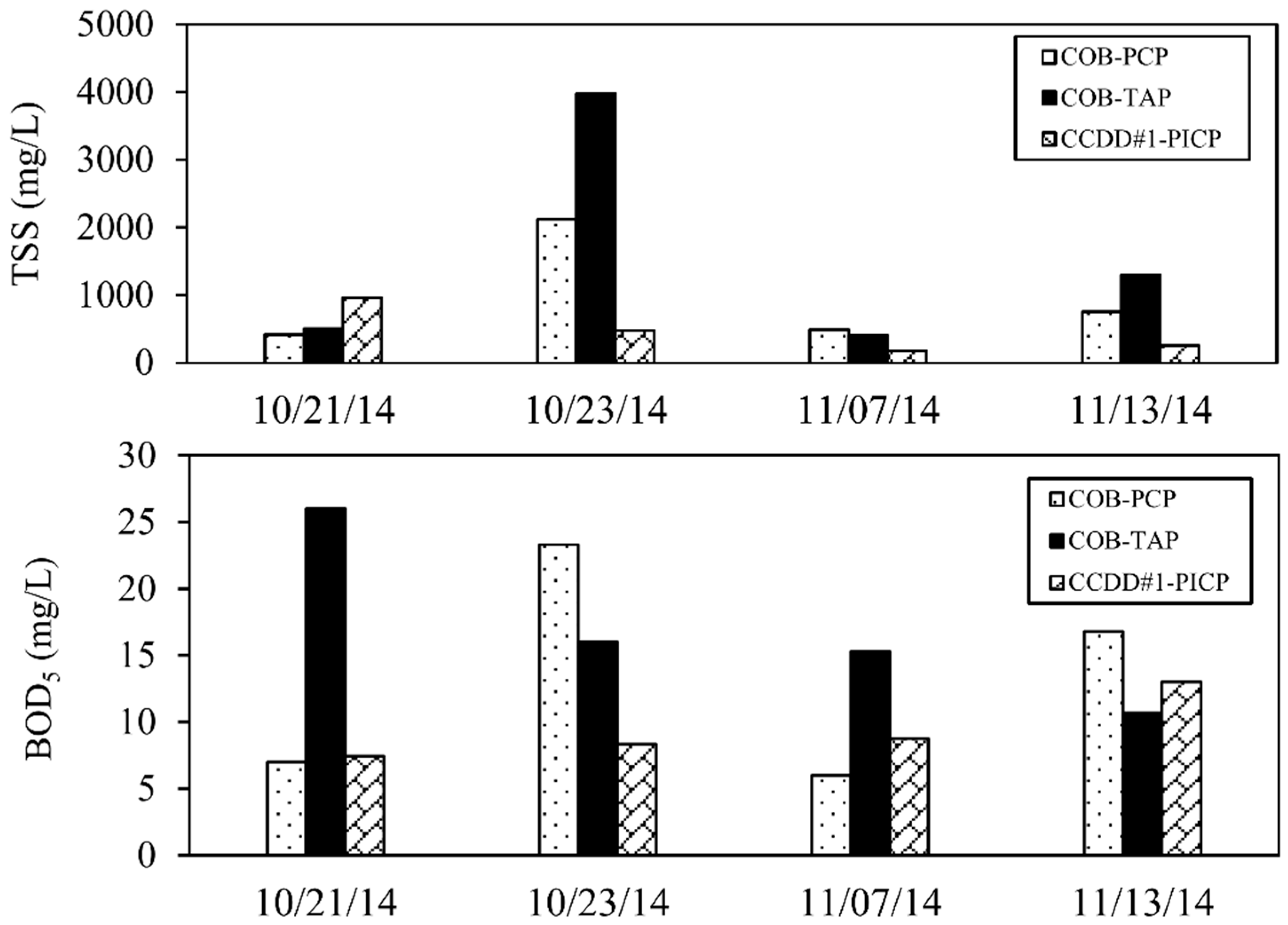
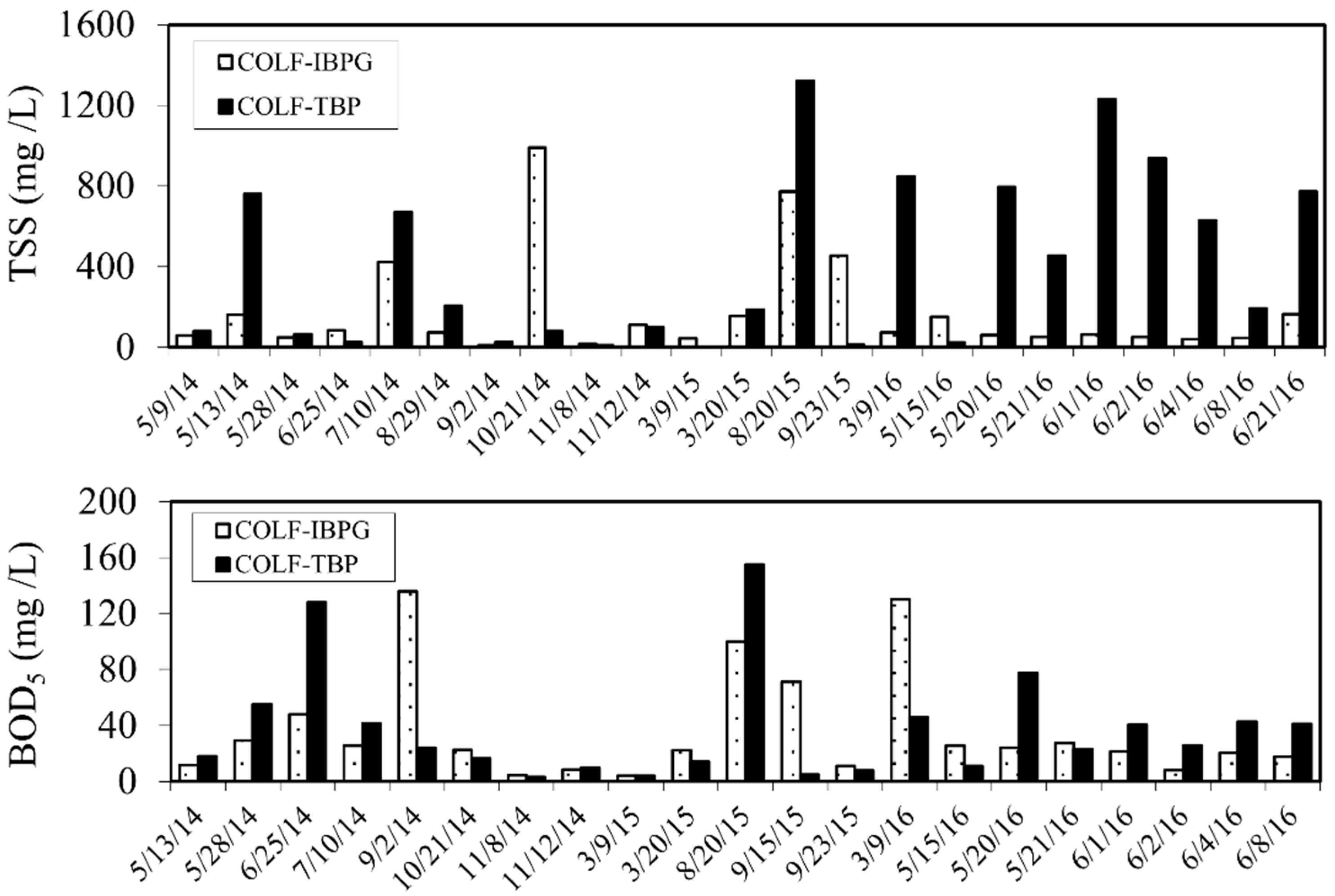

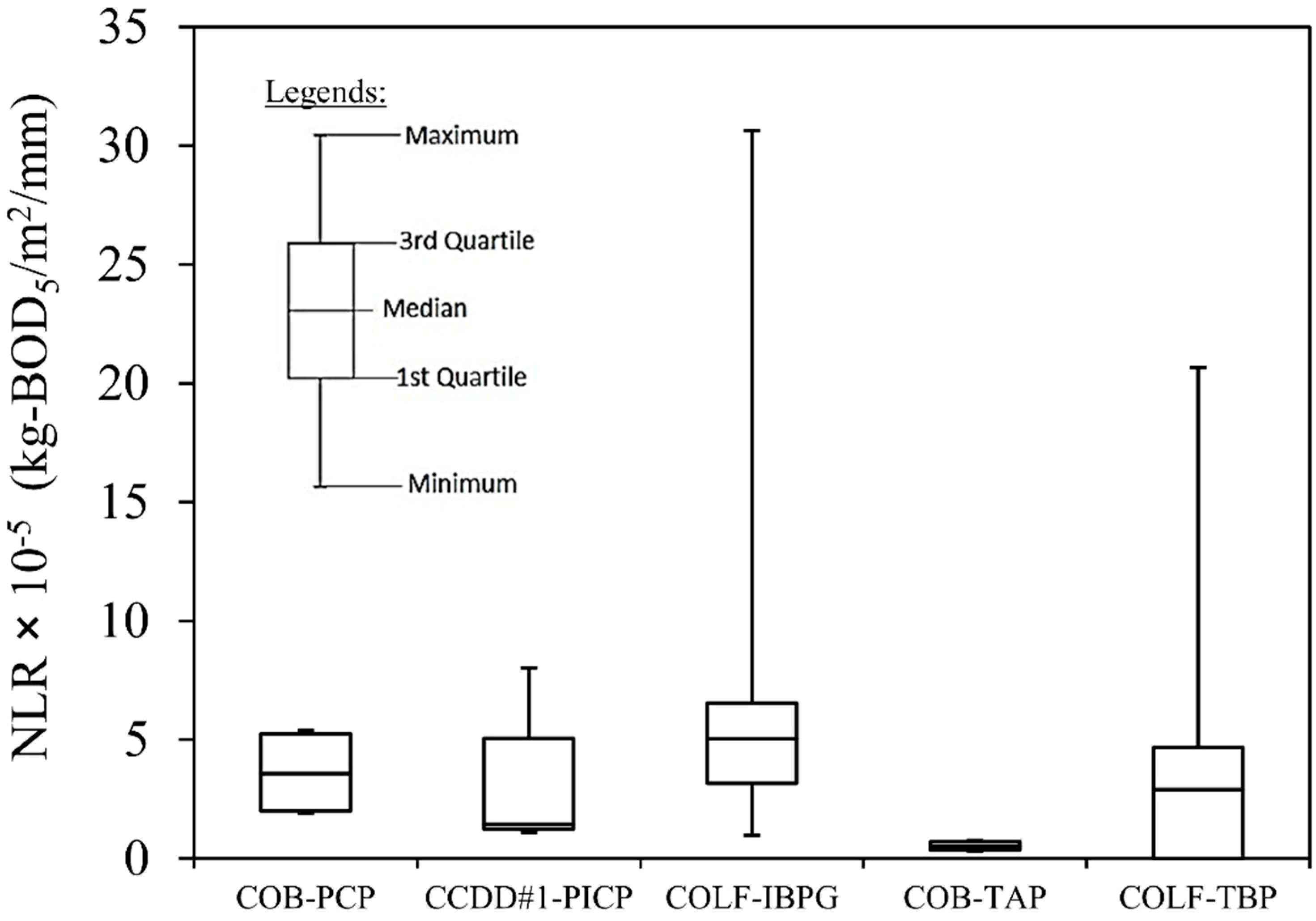
| Site Location | City | Pavement Type | Pavement Surface Area (m2) | Drainage Area (m2) | Drainage to Pavement Area Ratio (DA/PA) |
|---|---|---|---|---|---|
| Monte Bella Park Parking Lot | Brownsville, TX | Porous Concrete Pavement (PCP) | 37 | 92.9 | 2.5:1 |
| Traditional Asphalt Pavement (TAP) | 153.29 | 153.29 | 1:1 | ||
| La Feria Recreation Center Parking Lot | La Feria, TX | Interlocking Block Pavement with Gravel (IBPG) | 209 | 785 | 3.76 |
| Traditional Block Pavement (TBP) | 242 | 913 | 3.77 | ||
| Cascade Park Parking Lot | Brownsville, TX | Permeable Interlocking Concrete Pavement (PICP) | 372 | 518 | 1.39:1 |
| Parameters | PCP | PICP | IBPG |
|---|---|---|---|
| Surface Infiltration Rate (mm/h) | 50,800 | 22,860 | 24,892 |
| Surface Porosity | 20% (Porous Concrete) | 35% (Polymeric Sand as Joint Filler) | 25% Pea Gravel |
| Base Aggregates Porosity | 35% (ASTM #57 Angular Washed Stone) | 38% (ASTM #57 Open Graded Aggregate) | 40% (Compacted Crushed Limestone) |
| Site Location | Monitoring Period | Type of Pavements | No. of Flow Monitoring Events | No. of Water Quality Samples Collected | |
|---|---|---|---|---|---|
| TSS | BOD | ||||
| COB | 09/2014–11/2014 | PCP | 13 | 4 | 4 |
| TAP | 13 | 4 | 4 | ||
| COLF | 05/2014–01/2016 | IBPG | 42 | 23 | 20 |
| TBP | 42 | 23 | 20 | ||
| CCDD#1 | 08/2014–03/2015 | PICP | 20 | 5 | 5 |
| Pavement Type | Normalized Volume Reduction × 10−3 (m3/m2/mm) | Runoff Reduction (%) | |||||
|---|---|---|---|---|---|---|---|
| Mean | STD | Median | 25% Percentile | 75% Percentile | |||
| PCP | 2.81 | 0.67 | 3.20 | 2.49 | 3.22 | 98 * | 87 ** |
| IBPG | 2.20 | 0.46 | 2.45 | 2.07 | 2.48 | 46 * | 88 ** |
| PICP | 1.28 | 0.52 | 1.62 | 1.06 | 1.63 | 96 * | 80 ** |
| TAP | 0.05 | 0.90 | 0.36 | 0.15 | 0.50 | - | - |
| TBP | 1.2 | 0.94 | 0.38 | 0.13 | 0.50 | - | - |
| Design Properties | Type of Permeable Pavements | Max. Rainfall Holding Depth (mm) | %Normalized Peak Flow Reduction | Mean NVR (×10−3 m3/m2/mm) | Mean TSS NLR (×10−3 kg/m2/mm) | Mean BOD5 NLR (×10−3 kg/m2/mm) |
|---|---|---|---|---|---|---|
| Surface (materials, porosity, and infiltration rate) | PCP: Porous concrete; 20%; 50,800 mm/h | - | 38–100 | 2.81 | 2.44 | 3.6 |
| PICP: Interlocking blocks with sand as joint filler; 35%; 22,860 mm/h | - | 31–100 | 1.28 | 0.58 | 2.8 | |
| IBPG: Interlocking blocks with pea gravel; 25%; 24,892 mm/h | - | 42–100 | 2.20 | 0.4 | 3.9 | |
| Base Reservoir (max. storage capacity, aggregates porosity) | PCP: 3 m3; #57 washed stone; 35% | 70 | - | - | - | - |
| PICP = 36 m3; #57 open graded aggregate; 38% | 123 | - | - | - | - | |
| IBPG: 38 m3; crushed lime stone; 40% | 136 | - | - | - | - |
© 2019 by the authors. Licensee MDPI, Basel, Switzerland. This article is an open access article distributed under the terms and conditions of the Creative Commons Attribution (CC BY) license (http://creativecommons.org/licenses/by/4.0/).
Share and Cite
Alam, T.; Mahmoud, A.; Jones, K.D.; Bezares-Cruz, J.C.; Guerrero, J. A Comparison of Three Types of Permeable Pavements for Urban Runoff Mitigation in the Semi-Arid South Texas, U.S.A. Water 2019, 11, 1992. https://doi.org/10.3390/w11101992
Alam T, Mahmoud A, Jones KD, Bezares-Cruz JC, Guerrero J. A Comparison of Three Types of Permeable Pavements for Urban Runoff Mitigation in the Semi-Arid South Texas, U.S.A. Water. 2019; 11(10):1992. https://doi.org/10.3390/w11101992
Chicago/Turabian StyleAlam, Taufiqul, Ahmed Mahmoud, Kim D. Jones, Juan César Bezares-Cruz, and Javier Guerrero. 2019. "A Comparison of Three Types of Permeable Pavements for Urban Runoff Mitigation in the Semi-Arid South Texas, U.S.A" Water 11, no. 10: 1992. https://doi.org/10.3390/w11101992
APA StyleAlam, T., Mahmoud, A., Jones, K. D., Bezares-Cruz, J. C., & Guerrero, J. (2019). A Comparison of Three Types of Permeable Pavements for Urban Runoff Mitigation in the Semi-Arid South Texas, U.S.A. Water, 11(10), 1992. https://doi.org/10.3390/w11101992




